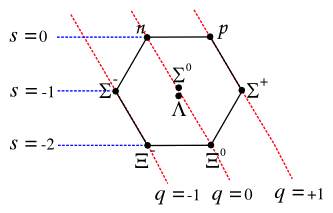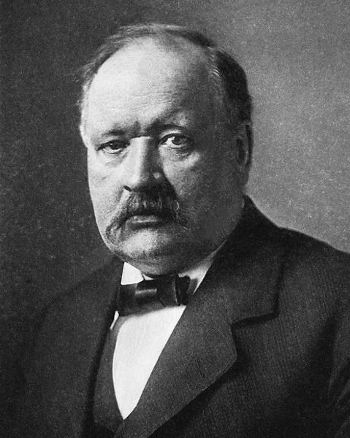The Eightfold Way(s)
April 12, 2012
According to
Benford's law, the number, eight, is the second least popular leading digit in lists of numbers describing most natural processes. Although the number, one, appears about 30% of the time, eight appears just 5.1% of the time, just ahead of nine, which appears 4.6% of the time.
The number eight, however, appears in quite a few things related to
science and
technology; for example,
• Eight corners in a cube
• Eight bits in a byte
• Eight carbon atoms in octane
• Eight notes in the western musical scale
(most of music is really math)
• Eight planets
(poor Pluto, demoted from planet status in 2006)
• Octet rule in chemistry.
• V8 engine
• Fairchild Eight
• Eight queens puzzle
• UTF-8 unicode character set
• PDP-8 computer
• STS-8 NASA Space Shuttle Mission
• Eight-point algorithm
• 8-QAM
• Eightfold Way
The last example, the Eightfold Way is probably the most fundamental of the batch, since it describes a
symmetry of
subatomic particles. This symmetry was named by the
physicist,
Murray Gell-Mann, as an allusion to the
Buddhist concept of the
Noble Eightfold Path. Discovery of this symmetry led to our present
quark model.

An octet of baryons, organized according to the Eightfold Way
(Rendered by the author using Inkscape, based on an image of Laura Scudder, via Wikimedia Commons)
When
scientists take a break from organizing our knowledge of
nature, they sometimes try to organize our idea of science, itself.
8+1 Science is a recent effort by educators to make science more accessible to students.[1] They propose a different method of science education that moves away from the memorization of facts to an understanding of eight fundamental science concepts. The "plus one" part is the anticipated follow-up stage in which students get accustomed to asking questions about nature, which is a fundamental part of science.
Here are the
8+1 Science Concepts.[2]
| How do Systems Interact and Change? |
I wrote about some aspects of science education in a
previous article (Stalled Science, March 9, 2012). It's quite evident that science education in the US needs an overhaul. The 2009
National Assessment of Educational Progress show that only 21% of
high school seniors in the US show proficiency in science. Not surprisingly, US students ranked twenty-third in scientific knowledge internationally.[1,3]
The 8+1 Science initiative began in 2006 as a
National Science Foundation research project called PROM/SE,
Promoting Rigorous Outcomes in Mathematics and Science Education. One problem that was identified is the insular way that science is taught; that is,
chemistry is taught without its necessary connections to
physics and
biology. The 8+1 Science effort encourages K-12 teachers to teach the connectedness of the scientific disciplines.[1]
William Schmidt, Distinguished Professor of statistics and education at
Michigan State University and leader of the advisory group for 8+1 Science, describes the program, as follows:
"Now is the time to rethink how we teach science... What we are proposing through 8+1 Science is a new way of thinking about and teaching science, not a new set of science standards. It supports basic concepts included in most sets of state standards currently in use and complements standards-based education reform efforts."[1]

Connecting the Sciences
Svante Arrhenius, who was awarded the 1903 Nobel Prize in Chemistry, made connections between physics, chemistry and biology.
Arrhenius was one of the founders of physical chemistry.
(Via Wikimedia Commons))
![]()
References:
- Andy Henion, "U.S. students need new way of learning science," Michigan State University Press Release, April 5, 2012.
- From the 8+1 Science Web Site. Used with permission.
- National Assessment of Educational Progress Web Site.
- 8+1 Science, YouTube Video, Apr 6, 2012.
Permanent Link to this article
Linked Keywords: Benford's law; science; technology; cube; bit; byte; carbon; atom; octane; note; western musical scale; music; mathematics; planet; Pluto; octet rule; V8 engine; Fairchild Eight; eight queens puzzle; UTF-8 unicode character set; PDP-8 computer; STS-8 NASA Space Shuttle Mission; eight-point algorithm; 8-QAM; eightfold Way; symmetry; subatomic particle; physicist; Murray Gell-Mann; Buddhism; Buddhist; Noble Eightfold Path; quark model; Inkscape; Wikimedia Commons; scientist; nature; 8+1 Science; 8+1 Science Concepts; atom; subatomic particle; cell; organism; electromagnetic radiation; laws of science; force; energy; matter; mass; conservation of energy; biology; evolutionary biology; National Assessment of Educational Progress; high school senior; National Science Foundation; Promoting Rigorous Outcomes in Mathematics and Science Education; chemistry; physics; William Schmidt; Michigan State University; Svante Arrhenius; Nobel Prize in Chemistry; physical chemistry; Wikimedia Commons.